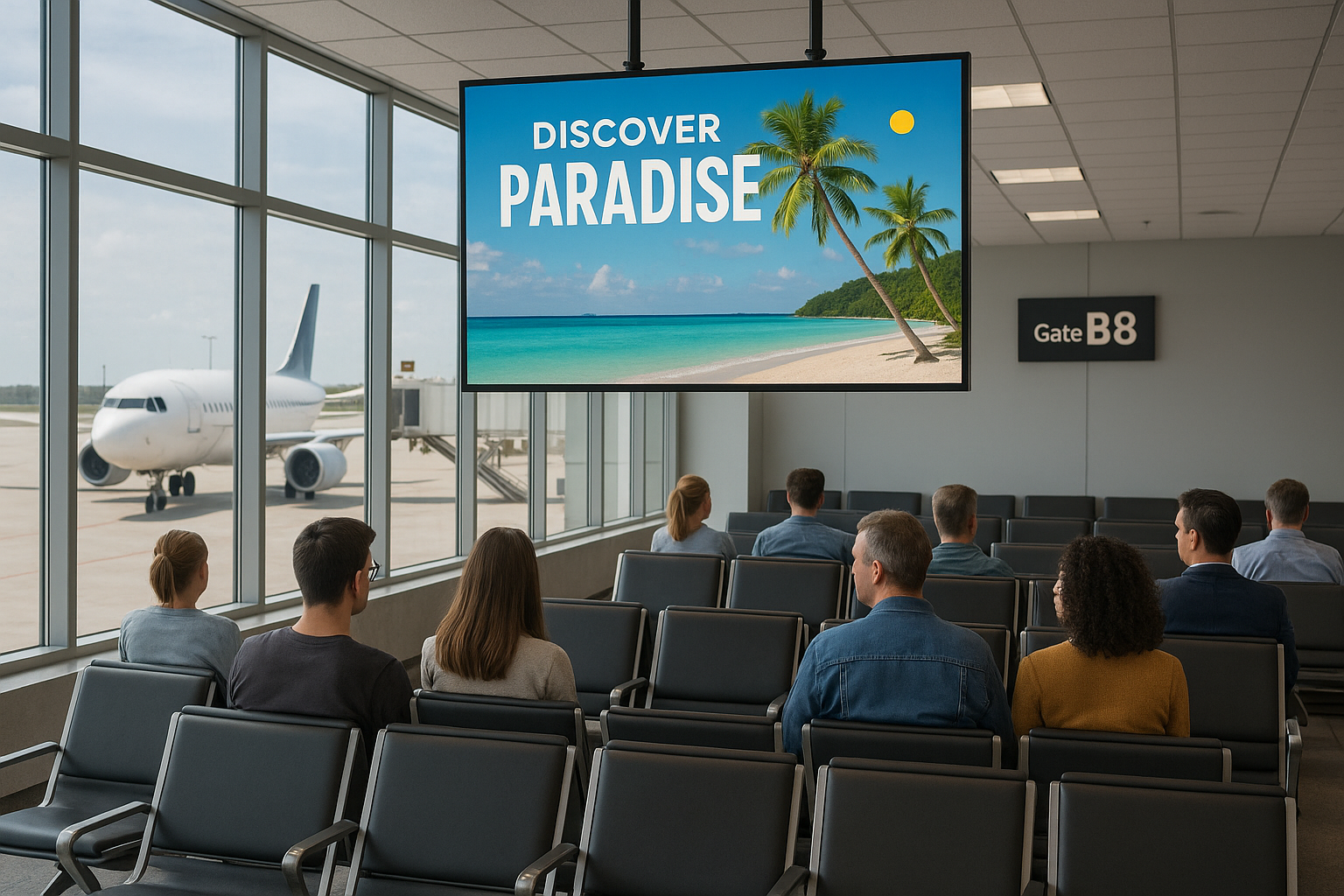Content
Digital-out-of-home (DOOH) advertising has become one of the fastest-growing segments in media — and for good reason. With dynamic screens reaching audiences in real-world environments like gas stations, doctor offices, auto shops, and retail centers, DOOH blends the visual impact of traditional out-of-home with the agility and measurability of digital media.
Many companies are proving just how effective DOOH can be when it’s relevant, well-placed, and efficiently managed. But as the space evolves, so do its complexities — and the tools needed to manage it.
What is Digital-Out-of-Home?
Digital-Out-of-Home (DOOH) advertising is a type of media that uses digital screens to show ads and content in public places — outside of people’s homes. These screens can appear in a variety of locations, such as at gas pumps, in medical waiting rooms, inside shopping malls, or across large digital billboards in airports and train stations.
What makes DOOH different from traditional advertising like posters or static billboards is its ability to display content that changes throughout the day. Since the content is digital, it can be updated remotely and scheduled to show at specific times or in response to certain conditions.
Some of the key advantages of DOOH include:
Dynamic content rotation: Advertisers can run multiple ads on the same screen throughout the day. For example, morning commuters might see different ads than evening shoppers.
Targeting by time and place: Ads can be scheduled to match the location, time of day, or even audience type — helping make messages more relevant and effective.
Real-time updates: DOOH networks can pull in data such as weather, traffic, or news to trigger specific ads. For example, a raincoat ad might display when it’s raining.
Measurability: Advanced systems can track impressions or estimate audience reach, giving advertisers useful data to understand performance and return on investment.
While these features add value, they also make DOOH more complex to operate. Companies running DOOH networks need to manage not only the screens themselves, but also the advertising content, scheduling rules, reporting tools, and relationships with advertisers and venue owners.
In reality, running a DOOH network involves much more than just installing screens. It’s about managing a full system that combines technology, advertising, content management, audience data, and business operations — all at once.
DOOH is a powerful and growing medium, but for operators, it requires the right systems and processes to keep everything running smoothly and to deliver real value to advertisers and audiences alike.
The Complexities of Running a DOOH Network
Operating a successful DOOH network involves navigating a web of moving parts:
1. Diverse Inventory and Environments
Each network has its own structure. There are companies that manage screens across medical offices, fueling stations, auto service centers. The type of venue determines the screen formats, dwell times, ambient noise levels, and available user data — all of which impact ad delivery strategy.
2. Content & Ad Loop Management
DOOH operators must carefully balance editorial content — such as health education, automotive tips, or general infotainment — with paid advertising within a tightly controlled content loop. This requires thoughtful curation to ensure a consistent viewer experience while meeting advertiser objectives.
Managing the ad loop goes beyond simply inserting ads between segments. Operators must implement competitive separation, ensuring that direct competitors are not shown back-to-back or within the same loop cycle — a crucial consideration for premium advertisers who demand category exclusivity. Additionally, venue-level exclusions must be respected: individual venues may choose to block certain ad categories or specific creatives that do not align with their brand, audience, or regulatory environment. This is especially important in sensitive settings such as healthcare, where inappropriate messaging can erode trust or create compliance risks.
Striking the right balance between monetization and editorial integrity — while honoring advertiser commitments and venue preferences — adds significant operational overhead. A robust content management system must accommodate all of these constraints, often at scale and in real time.
3. Dynamic Pricing Models
Not all ad space is created equal. Variables like venue size, location, time of day, saturation levels, and advertiser exclusivity all impact value. Building a pricing strategy that reflects these inputs requires a system that understands nuance.
4. Sales Complexity
Unlike digital display ads, DOOH sales can be structured in a variety of ways. Advertisers may purchase based on impressions, where they pay for each individual view of their ad. Alternatively, they might buy access to an entire venue, allowing their content to run on all screens within a specific location. Some campaigns are sold by screen, giving advertisers control over specific devices regardless of location. In cases where user-level data is available, sales can be structured by unique users to avoid counting repeat views. Finally, inventory can also be packaged and sold based on geography or content segments, targeting ads to specific regions or thematic categories.
For larger networks, this level of flexibility introduces significant complexity. Managing diverse pricing models and ensuring accurate campaign delivery becomes especially challenging when custom agreements or branded sponsorships are part of the mix.
5. Distribution Methodologies
DOOH networks have traditionally favored Programmatic Direct sales, where inventory is reserved in advance of a campaign’s start. This model suits the relatively predictable nature of DOOH environments, offering advertisers guaranteed placements and allowing operators to maintain control over timing, location, and content delivery. It also supports direct sales relationships and long-term sponsorships, which are common in verticals like healthcare and automotive services.
However, many networks are now adopting Real-Time Bidding (RTB) to tap into a broader pool of programmatic demand. RTB enables dynamic allocation of ad space based on contextual triggers or audience data at the moment of playback. While this can boost fill rates and revenue, it introduces operational complexity. Managing both Programmatic Direct and RTB simultaneously requires infrastructure that can intelligently allocate inventory, prevent conflicts, and support hybrid workflows across different sales channels.
What to Look for in a DOOH Management System
If you’re running or scaling a DOOH network, choosing the right system to manage your operations is mission-critical. Here’s what to prioritize:
Flexible Inventory Modeling
Your system should support multi-level segmentation — by screen, venue, loop, or even custom tags — without forcing you into rigid structures. Whether you sell impressions, devices, or bundled packages, the system should adapt to you.
Customizable Campaign Workflows
You need a platform that understands your sales cycle. Can it handle direct deals, pre-sold sponsorships, and RTB demand? Can it apply targeting rules without manual intervention? Does it accommodate multi-product packages across locations?
Seamless Content & Loop Control
Editorial and advertising content must be blended without violating local regulations, contractual terms, or viewer trust. Your CMS should offer granular control over loop composition, conflict management, and priority overrides — all at scale.
Smart Reporting & Attribution
Advertisers expect data. Your system should offer impression-level reporting, playback verification, and performance breakdowns by screen, venue, or creative — especially if you’re blending direct sales with programmatic.
Scalability Without Rework
As your network grows, the complexity of campaign setup and content delivery shouldn’t grow linearly. The system should support bulk operations, reusable templates, and scalable APIs to keep your team focused on growth, not admin work.
The Right People Behind the Product
Just as important as the features are the people you’ll be working with. Whether it’s onboarding, customization, or ongoing support, the vendor’s team should align with your company’s work style, values, and pace. Cultural fit matters — not just for day-to-day communication, but for long-term success. Look for a partner who listens, adapts, and treats your challenges as their own. The right technology with the wrong support team can become a liability; the right people can help you get the most out of the platform and evolve alongside your business.
Final Thoughts
DOOH is no longer a niche — it’s a core part of the modern advertising mix. But with that growth comes the need for more intelligent systems that match the medium’s potential. For companies like yours operating in specialized verticals, the key isn’t just screen count — it’s operational excellence.
If you’re reevaluating how your business manages campaigns, inventory, and content, now is the time to invest in a system purpose-built for DOOH complexity.
Want help evaluating or building the right tools for your network? Let’s talk.






